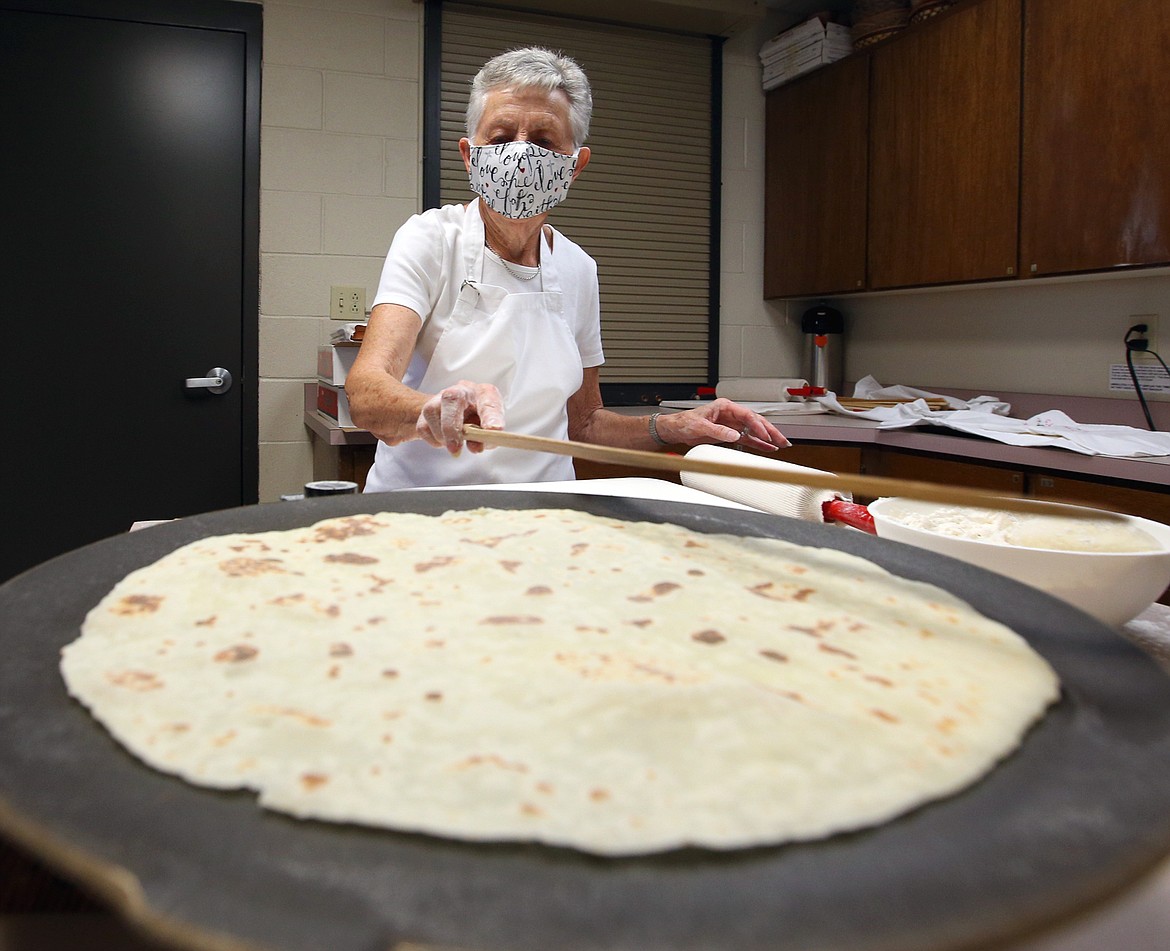For the love of lefse
COEUR d’ALENE — It starts downstairs with the men.
In this case, Dave Childs, Paul Hunt, Tad Johnson and Mert Barth.
“This is the potato prep area,” Childs says.
On a Wednesday morning at Trinity Lutheran Church, these four boil (about 30 minutes until soft), peel (with knives, wearing gloves because they’re hot) and grate the potatoes (looks like rice when it comes out of the handheld grater). Before they’re done, that will be 300 pounds over two days.
“These are getting close,” Childs says as he opens the lid and steam sneaks from the pot. “This first batch is really important because they may catch up to us.”
Then, the spuds are set out them out to cool, about 30 minutes, before being carried upstairs for the next step in the process of making Norwegian flatbread, better known as lefse.
“My mom used to make lefse,” Childs said. “She showed us how.”
Not everyone is there because they love lefse.
“I do it just because my wife does it,” Johnson said, laughing.
“It’s a cultural thing,” adds Barth. “I can remember my mother doing it on a cook stove, the old flat cook stove.”
In the next phase, (this is the condensed version) the potatoes are mixed with flour, a bit of sugar, butter and heavy whipping cream. Then, they are formed into “hockey pucks,” rolled out flat and round, cooked on a griddle for a few minutes on each side, covered and cooled, then folded and packaged, and finally, frozen.
About 20 volunteers will make some 1,600 rounds in two days.
“These are perfectly made lefse pieces, oh my goodness,” says Dolores Johnson as she prepares a sample. “Now, warn your stomach because it’s going to hit hard.”
Lefse is a tradition passed down through generations. For Johnson, she learned by watching her mom while growing up in North Dakota.
She’s shared it with her oldest daughter and they still make lefse together.
“My grandchildren love it,” Johnson said proudly.
She insists you do not call it a tortilla and says not everyone will like it.
“It’s unique,” Johnson said. “You gotta have a taste for it. My husband makes fun of it, which I think is terrible.”
The lefse will be sold at the church bazaar on Nov. 7 and it goes quickly. Last year, more than 300 packages, four pieces to each package, were snapped up in 14 minutes.
One year a trucker came in and offered to buy everything they made with plans to sell it in California.
They turned him down flat.
So if you want some – the price is $7.50 a package — get there before doors open at 8. a.m.
It’s a fundraiser led by the women’s group of Trinity Lutheran Church.
Everyone involved Wednesday and Thursday wore masks and hands were washed often.
“Not a very big crew with this COVID thing,” said Beverly Knutson, as she used a long stick to flip the lefse over on a griddle set to about 500 degrees.
“It doesn’t take long,” she said, noting she watches for bubbles and browning.
She wants it to keep a little moisture.
“If you leave it too long, they get hard,” she said.
For Kathy Benson, her job is to form the fresh dough into “hockey pucks” and she’s still learning to master it.
She admits it’s more a love of the Lord than lefse as to why she does it.
“It helps the church. I’m sorry but that’s it,” she said, smiling. “I’m not a lefse lover.”
The taste, she says quietly, is bit blah.
“That’s what I find,” Benson said. “They say if you grew up with it, it’s so delicious.”
She notes that most everyone else is a fan of the Norwegian treat.
“When we have a bizarre, they line up and fight over getting it,” she said.
Cindy McManus, president of the Sons of Norway, said her grandmother made lefse weekly.
“When she passed away, she gave me all her stuff, her roller, her griddle,” she said.
And to this day, McManus makes it monthly at home.
McManus added that this is not the lefse they eat in Norway, but rather an “immigrant recipe” because it has potatoes in it. They couldn’t afford all the flour.”
There is a fine line to making lefse right.
Winnie Barth was carefully brushing away flour from the round on the griddle.
”It will kind of burn if you don’t,” she said.
“You notice the bubbles come up, then you know it’s starting to get done,” she said.
The piece she was watching wasn’t quite done as she turned it over.
“So I give it a little more time,” she said.
From there, it goes to the cooling table, where it is covered with a cloth, even fanned occasionally, so it dries out but not too much.
“After it’s really cool, you fold into fourths and put in plastic bags and its ready for freezer or to to be sold right away,” she said.
Sharon Alexander said the lefse will last a long time in the freezer, so it’s good to save for the holidays.
“It’s just potatoes, butter and cream,” she said.
People add brown sugar, jam, butter, or cinnamon to lefse before eating it.
“It’s personal preference,” Alexander said.
“To me, it’s a delicacy,” Dolores Johnson added. “It’s not like a tortilla, it’s a delicacy, so you eat it that way.”
By the way, you can buy lefse in some local grocery stores, and in the Midwest, where it’s wildly popular, you can find it in convenience stores.
But there’s one problem.
“They’re not homemade,” Alexander said with a smile.
And love is an extra ingredient at Trinity Lutheran Church.

















